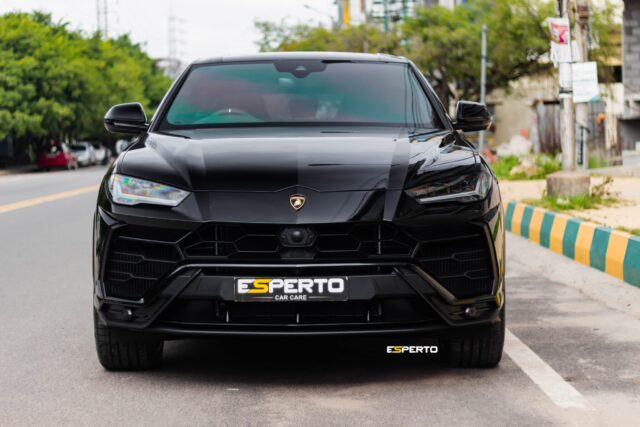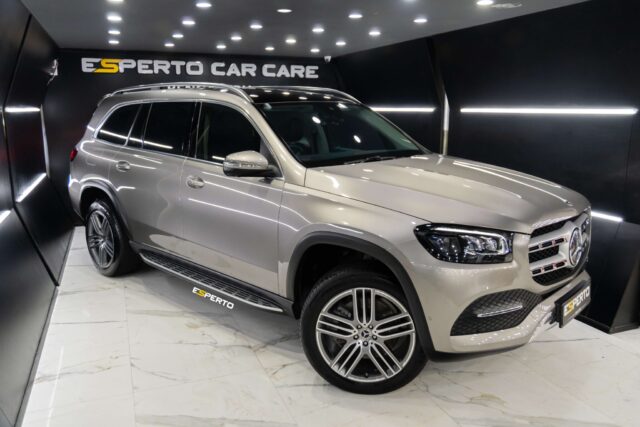Sun protection film is a specialized coating designed for applied to glass, blocking harmful ultraviolet rays while regulating indoor temperatures by preventing solar heat entry. The film functions through layers that either absorb or reflect UV light, ensuring interiors remain color-stable and reduce the load on air conditioning systems. Its varied types, including tinted and clear, cater to specific needs in buildings and vehicles. Continue engaging with available detailed resources to explore its benefits and installation techniques further.
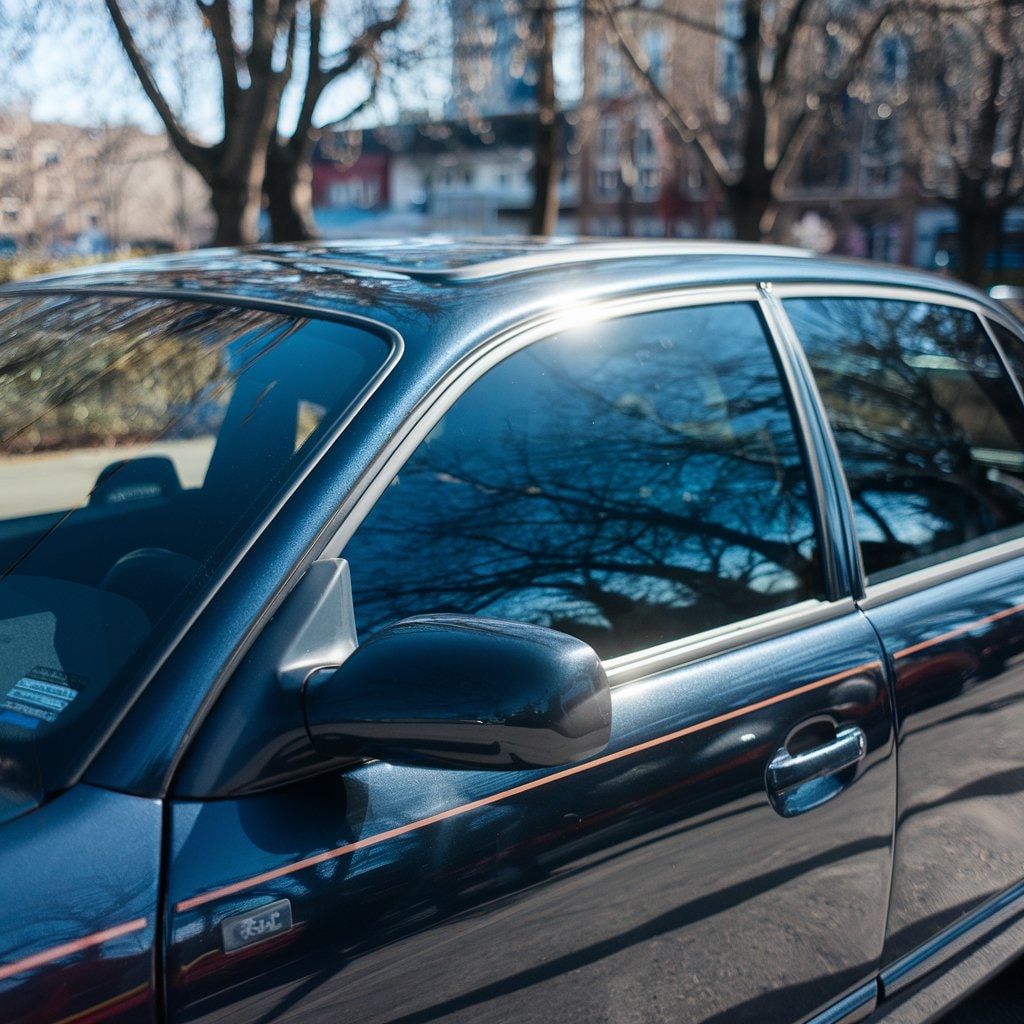
What is Sun Protection Film and How Does it Work?
Sun protection film is a specialized coating applied to glass surfaces to block harmful ultraviolet (UV) rays from penetrating indoor spaces.
This film primarily consists of polyester layers that enhance durability and UV resistance.
The technology behind these films focuses on reflecting or absorbing UV light, thereby protecting interiors from sun damage and reducing heat.
Understanding Sun Control Film
While for many years people seek ways to mitigate the intense effects of solar radiation, sun protection film offers a practical solution.
Sun control film, also known as sun control window film or solar control films, is designed to be applied to glass panels of windows to reduce the penetration of ultraviolet rays and heat from the sun.
By blocking UV rays, these films provide UV protection, contributing to indoor environments’ comfort and health safety. Additionally, they help energy savings by lowering the need for air conditioning.
The window film reflects or absorbs solar energy, offering heat protection and maintaining a cooler indoor climate without compromising natural light.
This makes sun control film an efficient tool for enhancing building sustainability.
Protect Your Vehicle’s Interior with Sun Protection Film
To effectively shield your vehicle’s interior from harmful ultraviolet rays, sun protection film utilizes advanced technology with multiple layers of protective material.
These specialized window films are designed to block UV rays by absorbing or reflecting UV radiation. This not only helps prevent sun damage to your car’s upholstery, dashboard, and trim but also reduces the risk of skin cancer by minimizing direct exposure to harmful UV rays inside the vehicle.
Key Benefits of Sun Protection Film for Vehicles:
- UV Protection: Blocks up to 99% of harmful UV radiation, preserving both the interior and passengers’ health.
- Prevents Interior Damage: Protects seats, dashboard, and other surfaces from fading, cracking, and deterioration.
- Skin Protection: Reduces prolonged UV exposure, lowering the risk of skin damage and related health concerns.
- Improved Energy Efficiency: Minimizes heat buildup inside the car, reducing reliance on air conditioning and improving fuel efficiency.
By installing high-quality sun protection film, car owners can enhance comfort, maintain their vehicle’s condition, and ensure long-term protection against UV damage.
The Role of Polyester in Sun Protection Films
Understanding the composition of sun protection films reveals the significance of certain materials in their efficacy.
Polyester films, an essential component in sun protection film, enhance the durability and performance of these films. Primarily, these films are made from high-quality polyester that serves as a stable base capable of withstanding exposure to ultraviolet (UV) light and other environmental factors.
When applied to glass, polyester films help in filtering out harmful UV rays while permitting visible light to pass through, consequently reducing glare without significant darkening.
Polyester’s inherent properties guarantee that the protection films also resist peeling and bubbling, prolonging the film’s lifespan and maintaining the aesthetic quality of the glass surfaces they protect.
Why Use Sun Protection Film on Windows?
Sun protection film offers multiple benefits when applied to car windows, primarily by blocking harmful UV rays and reducing heat buildup inside the vehicle.
This significantly enhances driving comfort, keeping the cabin cooler and more comfortable, especially during hot and sunny conditions.
Additionally, in automotive applications, window film helps protect the vehicle’s interior from fading and cracking while shielding passengers from prolonged sun exposure.
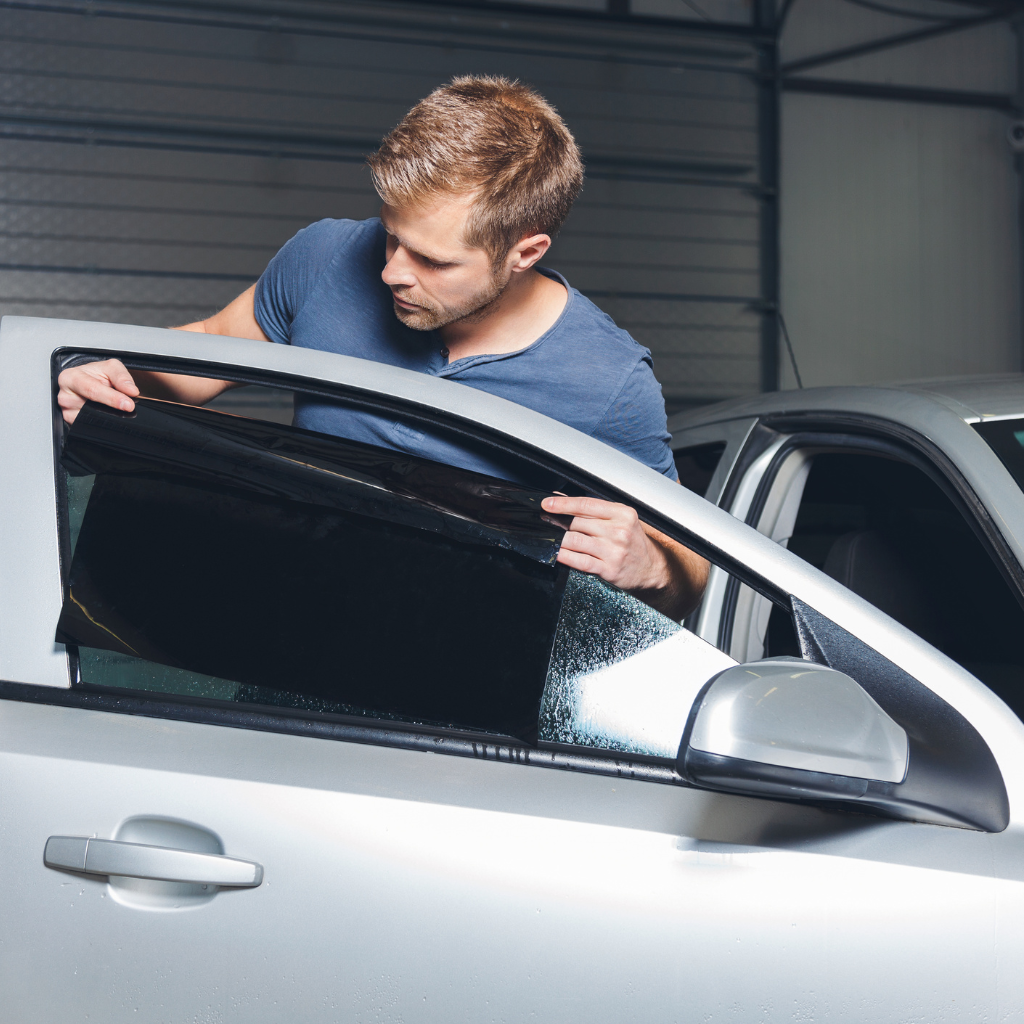
Block UV Rays and Reduce Heat
While many focus on aesthetics and privacy, sun protection film primarily blocks harmful UV rays and reduces the heat transmitted through car windows.
Sun protection film, often called solar film or sun control window film, incorporates advanced technology to enhance protection and efficiency.
These films filter out ultraviolet light and minimize heat buildup, making them an essential addition to any property, seeking comfort and safeguarding against sun damage.
Enhancing Comfort with Solar Window Film
Enhanced comfort is a primary benefit of applying sun protection film to windows. Solar window film effectively blocks significant amounts of heat from entering indoor spaces, increasing comfort levels and reducing excessive air conditioning usage. This control over indoor temperatures helps keep environments cool and leads to lower energy costs.
| Benefit | Description | Impact |
|---|---|---|
| Temperature Regulation | Sun protection film limits heat entry. | Cooler indoor environments |
| Reduced Energy Costs | Less reliance on air conditioning. | Lower utility bills |
| Comfort Improvement | Maintains consistent temperatures. | Enhanced living/working areas |
| UV Protection | Blocks harmful UV rays. | Protects against skin damage |
| Glare Reduction | Decreases the intensity of sunlight entering. | Easier viewing of screens |
Sun Protection for Cars and Vehicles
Applying sun protection film is not just beneficial for buildings—it also plays a crucial role in protecting cars and other vehicles. When sun control window film is applied to a car’s side and rear windows, it provides several important advantages.
Car window film is specifically designed to block harmful UV rays, which can cause interior fading, deterioration, and potential health risks for passengers.
Key Benefits of Sun Protection Film for Cars and Vehicles:
- UV Protection: Blocks up to 99% of harmful UV rays, safeguarding passengers and preserving the vehicle’s interior.
- Temperature Control: Helps keep the vehicle’s interior cooler, reducing the strain on air conditioning.
- Privacy and Security: Tinted windows enhance privacy and add an extra layer of security.
- Reduced Glare: Minimizes glare from the sun, improving driving comfort and visibility.
Installing high-quality window film on your car or vehicle enhances comfort, safety, and long-term protection against sun damage.
What Are the Different Types of Sun Control Films?
Sun control films come in various types, each designed to meet specific needs for cars and other vehicles.
These films differ in material composition, glare reduction, and visible light transmission (VLT) capabilities.
Understanding these differences is essential for selecting the right film to improve comfort, reduce heat, and protect your vehicle’s interior from sun damage.
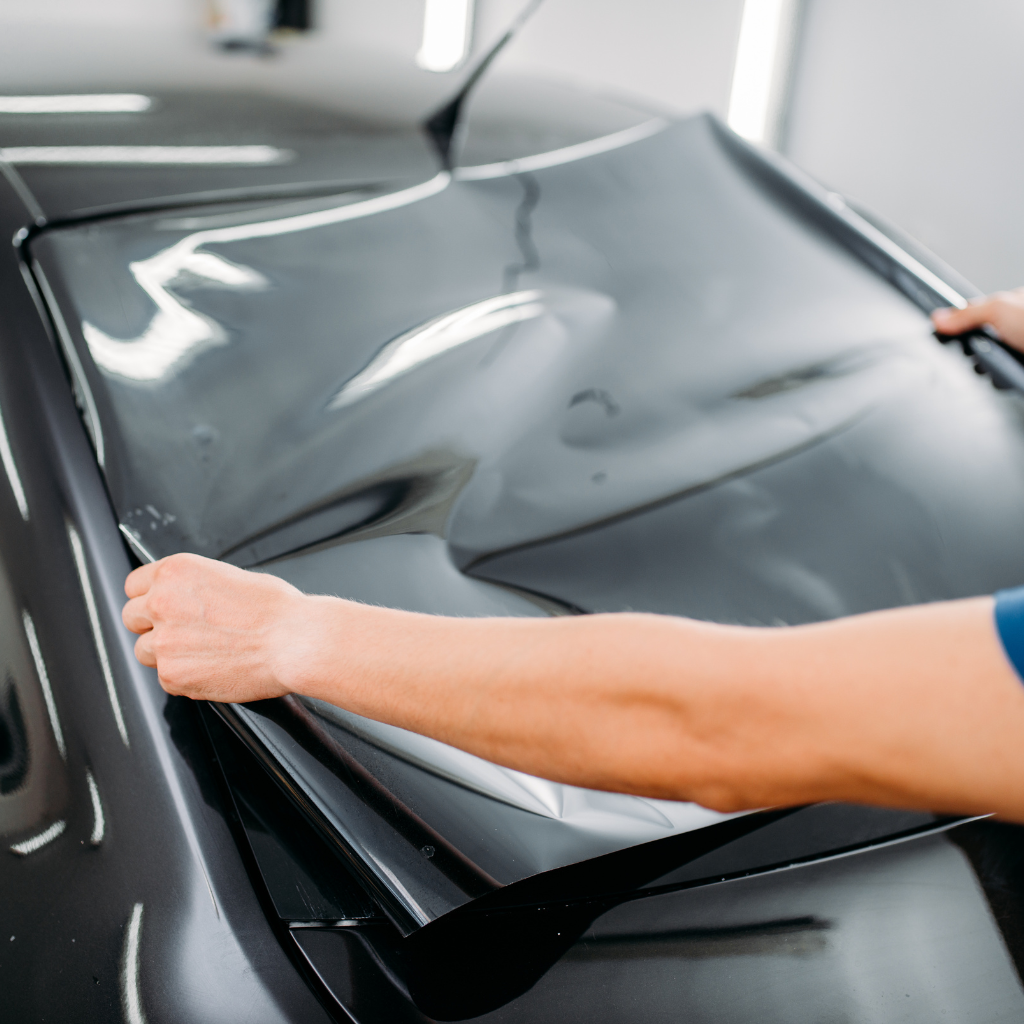
Exploring Types of Window Films
While there are numerous options available for sun control, window films are particularly effective in blocking harmful UV rays and reducing glare.
Various types of films offer distinct benefits depending on the specific needs of a space. Here are four main types of sun protection film:
- Tinted Films reduce glare and heat by absorbing solar energy before penetrating glass surfaces.
- Explicit Films: Primarily used for UV protection without altering the appearance of the glass.
- Metalized Films: These reflect solar energy away from the building, improving solar control while providing a mirrored appearance.
- Hybrid Window Film: Combination of dyed and metalized films.
- Ceramic Window Film: Made with ceramic particles that block heat, UV rays, and glare.
Comparison of Car and Vehicle Window Films
While both car and vehicle window films serve the primary purpose of blocking UV rays and reducing heat, their specifications and applications differ to meet the distinct needs of different types of automobiles.
Car window films are designed with a strong adhesive to withstand the frequent movement of windows, door closures, and vibrations during driving. They also enhance safety by reinforcing glass, reducing the risk of shattering in accidents.
In contrast, larger vehicle films, such as those used for trucks, buses, or RVs, often focus more on maximizing heat rejection for improved comfort during long journeys. These films may have varying levels of tinted windows and UV protection to suit different visibility and privacy needs.
Both types provide excellent UV protection, but differences in material composition and thickness ensure optimal performance and durability based on the vehicle type.
Understanding VLT and Glare Reduction
When selecting sun protection films for vehicles, it’s essential to consider their ability to regulate light, reduce glare, and enhance overall comfort. Car window films are designed to control the amount of sunlight and heat that enters the vehicle, improving both safety and driving experience.
Types of Automotive Sun Protection Films:
- High VLT Films: Allow more natural light into the vehicle while still blocking harmful UV rays, maintaining visibility and a bright interior.
- Low VLT Films: Provide significant glare reduction, ideal for driving in bright conditions and enhancing privacy.
- Safety and Security Films: Reinforced layers help hold shattered glass together in case of an accident, offering added protection.
- Decorative & Privacy Films: Available in different tints and patterns, these films provide sun protection while improving the vehicle’s appearance.
Choosing the right sun protection film for your car can significantly enhance driving comfort, reduce interior heat, and protect both passengers and upholstery from sun damage.
How to Apply Sun Protection Film Effectively?
Applying sun protection film effectively requires careful attention to preparation, installation, and maintenance.
Common mistakes during application can be mitigated with proper techniques and knowledge.
Ensuring the film’s longevity involves regular maintenance and periodic reviews of the film’s condition.
Preparation and Installation Steps
To effectively apply sun protection film, beginning with a clean, dust-free window surface is vital.
Proper installation steps are essential for both car and vehicle applications, guaranteeing maximum effectiveness of the sun control features. The films are available in various types, including options for rear and side windows that typically use self-adhesive tapes.
Key preparation and installation steps include:
- Cleaning the Surface: Confirm the regular window is entirely free of dirt and oils.
- Measure and Cut: Accurately measure the window and cut the film to size.
- Apply the Film: Start from the top, gently smoothing out any bubbles as you go.
- Sealing: Secure the edges of the film to prevent peeling and confirm durability.
Common Mistakes and How to Fix Them
Although the application of sun protection film seems straightforward, several common mistakes can markedly impair its functionality and appearance.
One frequent error is failing to properly clean the window before application, leaving particles that cause bubbling under the film. To fix this, thoroughly cleanse the surface with a suitable cleaning solution and a lint-free cloth before applying the film.
Another mistake is misaligning the film during installation, leading to gaps that allow sun exposure, potentially causing skin damage and fading items like computer screens. Carefully measure and cut the film, using guides to guarantee it aligns correctly.
Maintenance Tips for Longevity
Proper maintenance of sun protection film is essential to extend its effective lifespan and maintain its protective qualities.
Careful upkeep not only preserves the film’s appearance but guarantees it continues to manage heat and energy within a building efficiently.
Here are some practical maintenance tips to promote longevity:
- Regular Cleaning: Use a soft cloth and mild detergent to avoid scratches and preserve clarity.
- Avoid Harsh Chemicals: Stick to ammonia-free cleaning solutions to prevent film degradation.
- Inspect Regularly: Check for any peeling or bubbling, which can compromise film effectiveness.
- Professional Advice: Consult installation experts for repairs or adjustments to guarantee peak performance and benefits.
How Does Sun Protection Film Impact Energy Efficiency?
Sun protection film reduces the heat entering a vehicle, enhancing energy efficiency by lessening the reliance on air conditioning.
This heat reduction allows for a more balanced use of natural visible light without the associated increase in temperature.
Additionally, in vehicles, sun protection film can improve fuel efficiency by minimizing the need for air conditioning.
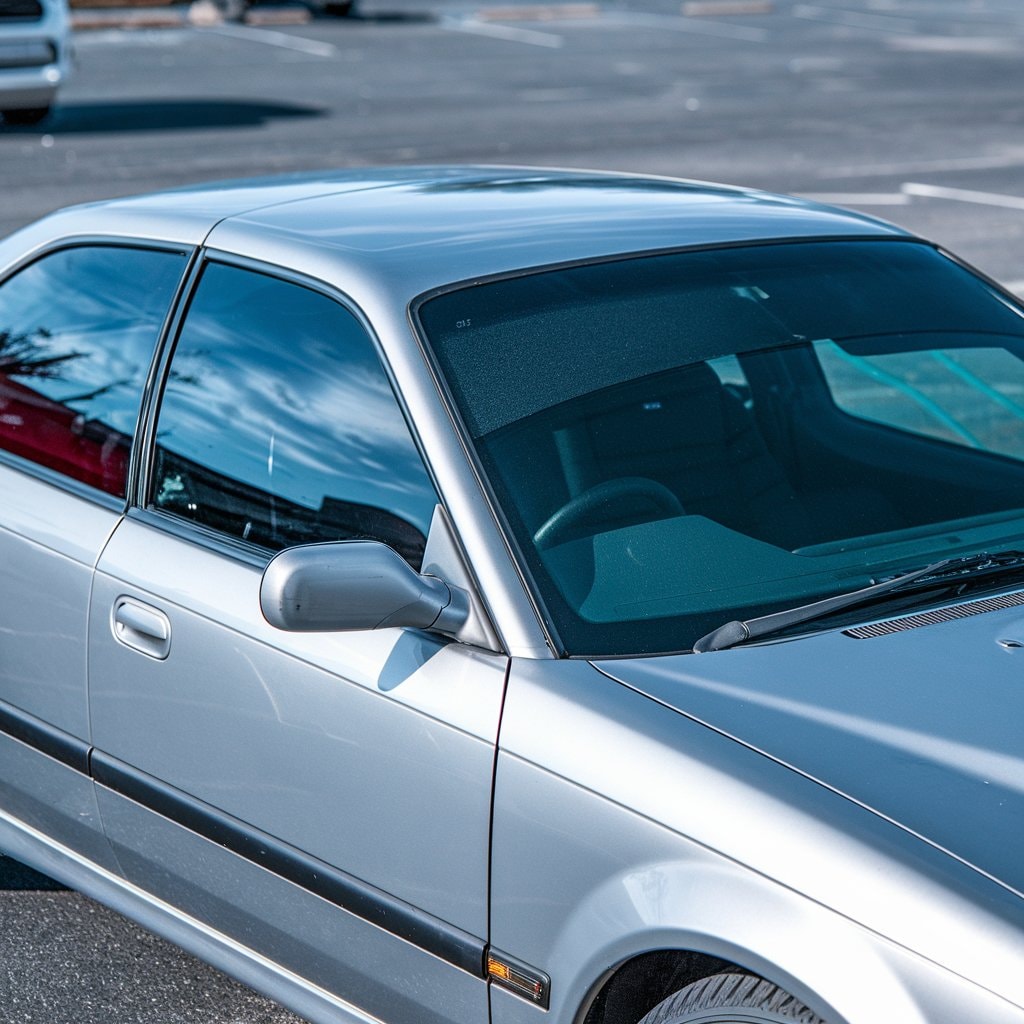
Reduce the Amount of Heat Entering Your Vehicle
Excessive heat inside a vehicle can cause discomfort, increase reliance on air conditioning, and accelerate wear on interior components. Installing sun protection film is an often cost effective solution to minimize heat buildup and protect your car’s interior.
Sun protection films, often made from advanced materials like ceramic or metalized layers, can significantly reduce the amount of heat and harmful UV rays entering your vehicle. This helps maintain a cooler and generally more comfortable environment, especially during hot summer months.
Key Benefits of Sun Protection Film:
- Blocks Harmful UV Rays: Helps prevent fading and premature aging of your car’s upholstery, dashboard, and interior surfaces.
- Reduces Heat: Limits the amount of heat that penetrates through windows, making your vehicle cooler.
- Enhances Comfort: Reduces the need for excessive air conditioning, leading to improved fuel efficiency.
- Preserves Visibility & Natural Light: Allows for a well-lit interior while cutting down glare and heat.
By applying high-quality window film, you can significantly extend the lifespan of your vehicle’s interior while ensuring a more enjoyable driving experience.
Impact on Air Conditioning and Natural Visible Light
By reducing the volume of heat entering a Vehicle , sun protection film considerably lowers the demand for air conditioning systems during hot weather.
This film is an effective barrier against the sun’s rays, particularly those known as UV, which contribute to the amount of heat within a space. By limiting heat ingress, the film helps maintain cooler indoor temperatures, making it more difficult for heat to accumulate and reducing the workload on air conditioning units.
This also results in enhanced energy efficiency and enhanced comfort.
Additionally, while blocking harmful UV rays, the film still allows natural visible light to enter, ensuring that the rest of the interior does not become overly dark.
This balance optimizes both the aesthetic and functional aspects of a living space.
Improve Fuel Efficiency by Reducing AC Usage
Applying sun protection film to windows greatly enhances a vehicle’s energy efficiency by reducing the need for air conditioning.
When equipped with sun protection film, a car blocks a considerable amount of the sun’s heat, keeping the interior cooler even on hot days. This reduction in heat penetration allows drivers to rely less on air conditioning, which can significantly improve fuel efficiency.
Key benefits include:
- Reduced AC Usage: Less reliance on air conditioning during hot weather.
- Improved Fuel Efficiency: Lower fuel consumption due to decreased AC demand.
- Cost Savings: Reduced fuel costs over the life of the vehicle.
- Enhanced Comfort: Cooler interior, making drives more comfortable in hot weather.
Conclusion
To sum up, sun protection film offers a practical solution for reducing glare and UV exposure while enhancing energy efficiency.
Available in various types, these films can be applied to windows to control heat and light entry, benefiting both comfort and cost. Whether for car or vehicle use, sun control film is a strategic choice that promotes a cooler, more energy-efficient environment, ultimately contributing to a sustainable balance between indoor comfort and environmental responsibility.



